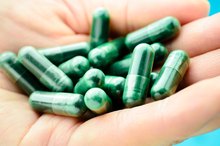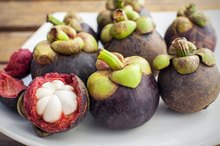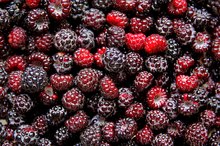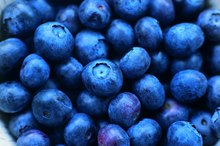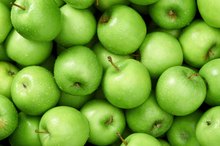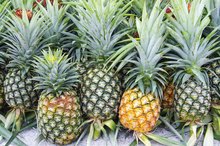What does fact checked mean?
At Healthfully, we strive to deliver objective content that is accurate and up-to-date. Our team periodically reviews articles in order to ensure content quality. The sources cited below consist of evidence from peer-reviewed journals, prominent medical organizations, academic associations, and government data.
- The British Journal of Nutrition: Effect of Tartaric Acid and Dietary Fibre From Sun-Dried Raisins on Colonic Function and on Bile Acid and Volatile Fatty Acid Excretion in Healthy Adults
- The British Journal of Nutrition: Effect of Tartaric Acid and Dietary Fibre From Sun-Dried Raisins on Colonic Function and on Bile Acid and Volatile Fatty Acid Excretion in Healthy Adults
- Nutrition Research: Cardioprotective Actions of Grape Polyphenols
- Nutrition Research: Cardioprotective Actions of Grape Polyphenols
- Advances in Nutrition: Cranberries and Their Bioactive Constituents in Human Health
- Advances in Nutrition: Cranberries and Their Bioactive Constituents in Human Health
- American Journal of Clinical Nutrition: Association of Raw Fruit and Fruit Juice Consumption With Blood Pressure: the INTERMAP Study
- American Journal of Clinical Nutrition: Association of Raw Fruit and Fruit Juice Consumption With Blood Pressure: the INTERMAP Study
- Wiener Klinische Wochenschrift: Effect of Prickly Pear--Opuntia robusta--on Glucose- and Lipid-Metabolism in Non-Diabetics With Hyperlipidemia -- A Pilot Study
- Wiener Klinische Wochenschrift: Effect of Prickly Pear--Opuntia robusta--on Glucose- and Lipid-Metabolism in Non-Diabetics With Hyperlipidemia -- A Pilot Study
The information contained on this site is for informational purposes only, and should not be used as a substitute for the advice of a professional health care provider. Please check with the appropriate physician regarding health questions and concerns. Although we strive to deliver accurate and up-to-date information, no guarantee to that effect is made.
Which Fruits Contain Tartaric Acid?
Tartaric acid is a white crystalline organic acid 4. The most common use for tartaric acid is in wine-making, where it plays a vital role in maintaining the color, chemical stability and taste of the finished wine product. Tartaric acid is also used as an acidifying agent in candy, jams and jellies to give these products a sour or tart taste. According to "The British Journal of Nutrition," tartaric acid consumption can have some healthy benefits for the digestive tract 1. Tartaric acid is commonly obtained by processing the crystalline wastes of wine vats, but it can also be found naturally in some fruits.
Grapes
Grapes contain the greatest concentration of natural tartaric acid. According to ScientificCommons.org, tartaric acid concentration in grapes increases throughout the ripening process and reaches its peak approximately 50 days after the grapevines flower. The tartaric acid concentration in grapes plays a vital role in wine-making. According to November 2008 issue of "Nutrition Research," consumption of grapes can have such health benefits as lowering your cholesterol and other heart-healthy properties.
- Grapes contain the greatest concentration of natural tartaric acid.
- The tartaric acid concentration in grapes plays a vital role in wine-making.
Cranberries
How to Ripen Oranges in the Microwave
Learn More
Cranberries are also a good source of natural tartaric acid. The tartaric acid content of cranberries is what gives raw cranberries a tart and sour taste. According to November 2013 issue of "Advances in Nutrition," the consumption of cranberries has such health benefits as lowering your risk of urinary tract infections as well as promoting gastrointestinal, oral health and even cardiovascular health 3.
Bananas
Tartaric acid is also found naturally in bananas, as noted in a report from the USDA National Organic Program 4. In addition to tartaric acid, bananas are also very rich in vitamins and minerals such as:
- vitamin B-6
- vitamin C
- potassium
- fiber
- according to USDA National Nutrient Database 4[5](https://ndb.nal.usda.gov/ 'inline-reference::USDANational Nutrient Database: Bananas
- Raw')
Consumption of bananas can yield a variety of health benefits due to the presence of these vitamins and minerals. Protection against heart disease and stomach ulcers are among the health benefits you receive from consumption of bananas. The May 2013 issue of the "American Journal of Clinical Nutrition" reports that banana consumption is also associated with a reduction in blood pressure 6.
- Tartaric acid is also found naturally in bananas, as noted in a report from the USDA National Organic Program 4.
- In addition to tartaric acid, bananas are also very rich in vitamins and minerals such as: * vitamin B-6
* vitamin C
* potassium
* fiber
* according to USDA National Nutrient Database 45 Consumption of bananas can yield a variety of health benefits due to the presence of these vitamins and minerals.
Prickly Pear
Hawaiian Spirulina Benefits
Learn More
The fruit of the prickly pear cactus is also a natural source of tartaric acid, according to the University of Texas. Native Americans consumed the flowers and skin of the prickly pear for medicinal purposes such as treating urinary ailments and providing nutrients to the pancreas and liver. The October 2002 German medical journal "Wiener Klinische Wochenschrift," reports that prickly pear also lowers cholesterol, blood sugar levels, triglycerides and uric acid in the body. The prickly pear fruit has a sour, tart taste due to the presence of tartaric acid, which makes it useful in products such as juices, jellies and liqueurs.
- The fruit of the prickly pear cactus is also a natural source of tartaric acid, according to the University of Texas.
- The October 2002 German medical journal "Wiener Klinische Wochenschrift," reports that prickly pear also lowers cholesterol, blood sugar levels, triglycerides and uric acid in the body.
Related Articles
References
- The British Journal of Nutrition: Effect of Tartaric Acid and Dietary Fibre From Sun-Dried Raisins on Colonic Function and on Bile Acid and Volatile Fatty Acid Excretion in Healthy Adults
- Nutrition Research: Cardioprotective Actions of Grape Polyphenols
- Advances in Nutrition: Cranberries and Their Bioactive Constituents in Human Health
- USDA National Organic Program: Tartaric Acid
- USDANational Nutrient Database: Bananas, Raw
- American Journal of Clinical Nutrition: Association of Raw Fruit and Fruit Juice Consumption With Blood Pressure: the INTERMAP Study
- Wiener Klinische Wochenschrift: Effect of Prickly Pear--Opuntia robusta--on Glucose- and Lipid-Metabolism in Non-Diabetics With Hyperlipidemia -- A Pilot Study
Writer Bio
Robert Shifko has more than 17 years' experience in the health care industry. Throughout his career, he has gained experience in pharmacologic research, clinical nuclear medicine, and most recently radiation health physics. He has obtained several certifications in nuclear medicine, epidemiology, biostatistics and as a medical radiation safety officer. He has always supported LIVESTRONG.

